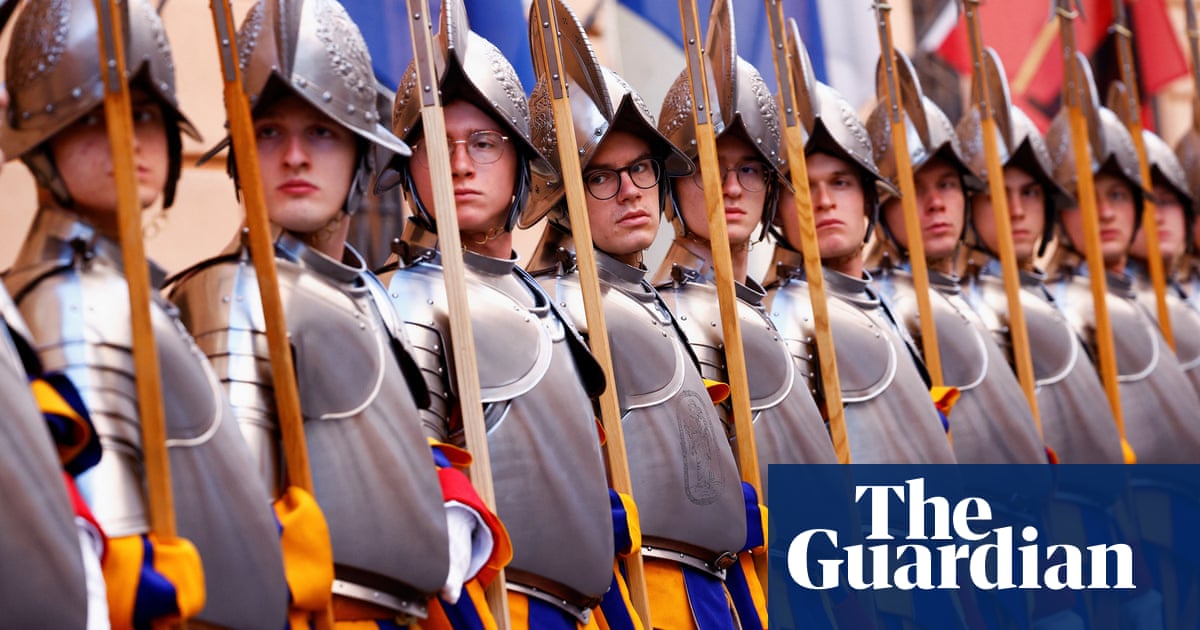
With their feathered helmets, ruffled collars and coloured, puffed-sleeve uniforms, the Vatican Swiss Guards are often likened by curious visitors to medieval court jesters. But while they willingly pose for photographs, the watchmen are not there to entertain.
Since the early 16th century, when Swiss mercenaries, revered for their bravery and loyalty, marched to Rome to serve Pope Julius II, the world’s smallest army has been enlisted at the Vatican to protect the pope, his residence and the city’s borders.
Last week journalists were given a rare glimpse of the guards’ barracks in the easternpart of Vatican City, and an insight into the background and daily lives of the troops as they rehearsed for the swearing-in of new recruits.
Dressed in their traditional red, yellow and blue garb complete with armour and halberds, the men practised an impeccably choreographed march in the barracks’ courtyard, each raising three fingers of their right hand to the sky to evoke the Holy Trinity while shouting the pontifical oath.
Among the 34 who will pledge to “sacrifice his life” to defend the pope at a ceremony on Monday is Renato Peter, 22, who was recruited from a village close to Sant Gallo, one of several in Switzerland that has provided young men for the elite corps for centuries.
He has dreamed of becoming a Swiss Guard since first seeing one at a Wednesday morning papal audience at St Peter’s Square at the age of 12.
“Then in the afternoon we went to see the barracks,” added Peter, who at the time was in Rome with his diocese. “I thought to myself: ‘Wow, what a cool job!’ I told my mum that ‘one day I will be a Swiss Guard … This dream never left me.’”
The guards may look quaint, but the men behind the Renaissance-style uniforms, designed by Col Jules Repond in 1914 and not Michelangelo, as many believe, have undergone a competitive application process and rigorous training to get this far.
Recruits must be male, Swiss, aged between 19 and 30, over 5ft 7in (1.74 metres), unmarried and devoutly Catholic with “an unblemished character”. They must undergo Swiss military service and commit to serving the pope for at least two years. They can get married after five years of service.
The halberd is their traditional weapon, but the troops are trained to use small modern-day arms, including the more recently introduced stun guns. Since 1981, when a plainclothes Swiss Guard rushed to the aid of a wounded Pope John Paul II after an assassination attempt on the pontiff, there has been a stronger emphasis on self-defence and anti-terrorism techniques.
In 2018 Pope Francis boosted the army’s number from 110 to 135, after a series of terrorist attacks in France and elsewhere in Europe, and in preparation of next year’s jubilee, when 35 million people are expected to visit the Vatican.
“Like all armies, we have to be prepared to face all situations,” said Cpl Eliah Cinotti, a spokesperson for the force.
On top of the military training, the recruits are put through intense psychological tests to ensure they have the mental capacity to adapt to life as a Swiss Guard. “Many fail at that point, or perhaps they get hired and only last a few months when they realise the career is not for them,” added Cinotti.
Although the role of the Swiss Guard today is partly ceremonial and partly serving as a security service to the pope, over history it has been engaged in ferocious battles.
The swearing-in ceremony is held each year on 6 May, which commemorates the anniversary of the army’s darkest hour in 1527, when all but 42 of 189 guards died while defending Pope Clement VII during the sack of Rome by the mutinous troops of the Holy Roman Emperor Charles V.
A vastly outnumbered army also prepared to die for the pontiff when Adolf Hitler’s forces entered Rome during the second world war, although in the end the Germans did not attack the Vatican.
Pope Francis refers to the guards as “his messengers” because a big part of the job today involves providing comfort to the people who come to the Vatican seeking help, according to Cinotti.
“They are desperate as maybe they have lost their job or their homes and the Vatican is their last hope,” he added. “Some people want to end their lives, and we have to try and prevent them from doing this. These situations can be very tough, but we have to help find solutions … even just listening can help.”
Although the army remains exclusively for men, a new barracks is being planned with the possibility of accommodating women. “It is up to the pope to decide whether women can join, and we will enact whatever he wants,” said Cinotti.
The guards work in six-hour shifts, sometimes 12 on busy days. They earn about €1,200 (£1,026) a month and on their time off are free to venture beyond the Vatican. They live together in shared dorms.
“Your life is pretty much 24 hours a day together,” said Peter. “But there is good camaraderie and you make really good friendships.”
He is feeling nervous about the swearing-in ceremony, especially as he has to play a small trumpet at the beginning, and so “all eyes are on you”.
But he is ready to serve the pope. “This is the best part of the job – he is among the most important people in the world and only 135 guys have the opportunity to do this.”











